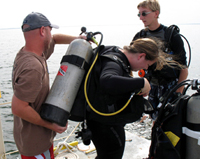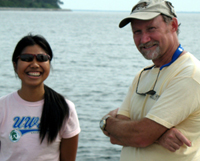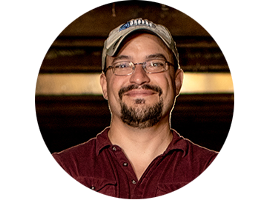2007

Maritime Field School 2007
Maritime Archaeology Field Methods is an intensive course designed to simultaneously teach students field techniques of archaeological excavation and documentation of maritime sites while producing outstanding archaeological results from the projects being worked on. Directing the field school this summer is Dr. John Bratten and Greg Cook, both professors of archaeology at The University of West Florida.
During the course of the summer, field school students' activities will include utilizing remote sensing survey using magnetometer and side scan sonar equipment, site testing and excavation on potential sixteenth-century shipwreck sites in Pensacola Bay, and hull recording and underwater photography of a nineteenth-century sidewheel steamboat in Seminole, Alabama, as well as site assessments and dives on known historic wrecks located in the area. UWF graduate students Wayne Abrahamson (Graduate Field Director, Seminole Operations) and Brian Adams (Graduate Field Director in training) will lead the way with support from fellow graduate supervisors in training Kendra Kennedy, Christine Mavrick, Bill Neal, Dean Nones, and Nicole Tumbleson. When not diving, students will perform topside duties such as dive tending and support, artifact recording, and database entry. While fieldwork is the focus of the summer session, it will also be supplemented by lectures and discussions on themes ranging from the colonization of northwest Florida, maritime landscapes and economic maritime connections in the Gulf region. Students may also be called on to participate in the conservation and laboratory analysis of recovered material.
By the end of the summer the students will have an understanding of the role of watercraft in the historic and economic development of the Gulf Region, basic ship construction and ability to recognize features of historic wrecks in Pensacola and surrounding waters, the role of seafaring in the colonization of Florida, and be able to identify maritime landscapes and their various components. They will also leave with an "archaeological toolkit" filled with tools such as a functional knowledge of working on boats and boating safety, basic knots, use of remote sensing and survey instruments, underwater navigation, underwater communication, GPS navigation, recording data underwater, "multi-tasking" while diving, underwater search patterns, underwater excavation, underwater site testing, hull recording, laying baselines and taking offset measurements, generating scale drawings, Direct Survey Method computer mapping system, and documentation procedures (field introduction to conservation notes, forms, and recovery bags). With these basic skill sets, the students will leave field school as competent underwater archaeologists.
Field School Blog

May 29 to June 1
Welcome to UWF’s Underwater Field School Blog! UWF got its underwater field school underway on Tuesday the 29th of May with a four day training period chock full of lectures, dive safety training, and underwater archaeology drills to prepare students to work on the phenomenal sites we have lined up for the summer. There was a great deal of excitement surrounding field school this year with the strong leadership provided by not only Dr. Bratten and Greg Cook but a strong graduate student presence with Wayne “Abe” Abrahamson and Brian Adams as field directors and the five graduate supervisors Kendra Kennedy, Christine Mavrick, Bill Neal, Dean Nones, and Nicole Tumbleson. Upon bringing the students into the fold and seeing their eagerness and talent, it seems that this excitement is warranted.
Tuesday brought us all together for the first time. Lectures were given on dive safety by Captain Lloyd and our resident boat miracle worker Steve McLin gave the students an in depth tour of the Marine Services Center. After a tasty burger and dog lunch, we worked on archaeological skills on land, practicing circle searches and baseline offsets, compass navigation, knot tying, and dredge assembly and disassembly. On Wednesday the students experienced cerebral saturation with lectures by Dr. John Bratten, Greg Cook, Abe Abrahamson, and Kendra Kennedy. These lectures ranged from overviews of ship construction, shipwreck archaeology, and use of remote sensing devices to specific site overviews of wrecks we will be diving this summer. In the afternoon we adjourned from the air conditioned confines of the Archaeology Institute back to the yard at MSC where the students practiced the art of measuring and drawing scale pictures of the boats. Thursday finally saw us immerse ourselves in water for the first time albeit in the UWF aquatic center, and the students got to apply the land lessons of the past two days as well as pass the dive safety requirements of our Dive Safety Officer, Captain Lloyd. As expected, the students were a smashing success and were ready to try some hands on experience. Friday we entered the real world. A Dive at the Seminole wreck allowed students to apply the week’s lessons in a real working environment. The visibility was particularly bad that day yet the students were unfazed and we are this year’s field school is well prepared to take on the archaeological challenges of the field season.
The success of this week brings a great deal of optimism for next week when we will be sending teams back to Seminole to continue work on the 19th century steam ship and out on the barge to work on our newest find, target 17. Please come back next week and see what we have uncovered.

June 4 to June 18
UWF underwater field school has officially taken off. Let me start by apologizing for the lag in blog updates. The responsibility lies solely on the writer (unfortunately that’s me) and with this posting and the next, we should be all caught up. Let me also take a second to thank our web designer Jeremy Moore. He has guided me as well as anyone could have guided someone as technology challenged as I am and has really made this thing possible. And without further ado.
Field school started in earnest Monday June 4, 2007 with Christine Mavrick’s and Nicole Tumbleson’s teams heading out to Seminole Alabama and Kendra Kennedy’s, Bill Neal’s, and Dean Nones’ teams christening our revamped barge in Pensacola Bay. The Seminole crews enjoyed decidedly better visibility than was seen our last day of training week. After an orientation dive, the students dove right into their work recording hatches and machinery off the still well articulated wreck. The Seminole wreck is unique in that it is a well articulated wreck in a relatively benign environment making it a perfect learning tool for students as well as being an interesting wreck to study. It is not without its hazards though. Students gained first hand knowledge of the smell of organic sediments and one student, Sarah Linden, came face to face with one of the legless inhabitants of the river. To her credit she took it in stride and by all accounts the Seminole dives were both productive and enjoyable for all. In week two Dean Nones’ and Bill Neal’s teams ventured out to Seminole and, despite some dog related problems, were able to produce some solid work on the starboard paddle wheel, devise protection for some of the more delicate artifacts on the wreck, and find time to enjoy Uncle Bubba’s delicious chicken.
The Barge crews had a learning curve of their own realizing just how much wind and weather affect our digs. Our first day on the barge saw us washed out by strong winds. These winds stayed with most of week 1 and made the diving difficult and visibility nearly non existent. By Friday, though, the winds laid down and all teams got in solid work with the dredge. Week 2 saw some of the same, though the weather cooperated more and we were able to operate almost every day with increasing productivity. We recovered Spanish olive jar sherds, dunnage, lead sheathing, and uncovered structural wood and ceiling planking in one unit. Our success through the week prompted us to open a second unit to the south by the end of the week. Kendra Kennedy’s team also set out off the barge with the magnetometer to search for more possible targets and performed circle searches on previously identified targets that had not been dove yet. Nicole and Christine’s teams joined the fun at the barge through the streamlining effects of trial and error, many of our concerns of too large a crew on the barge were abated as the students formed into a well oiled machine during dive operations. By the end of week two, we are all optimistic that this may be a 16th century wreck and are encouraged by the Spanish artifacts. We are hoping by the end of the summer we can say that this is the second De Luna wreck found in Pensacola Bay.

June 19 to July 1
Things have really started happening at field school now. Weeks 3 & 4 have produced some great finds and have graced us with visits from some very interesting people. Dr. Roger Smith, Debra Schefi, and Dan McLarnon from state of Florida and Mark Staniforth and Patti O’Toole from Flinders University in Australia all came out to the wreck to check it out as well as Della Scott-Ireton from the Florida Public Archaeology Network. All seemed to have a great time and were intrigued with the projects we are working on. Meanwhile the students continued to develop their archaeological skills as we get closer to the realization of our summer’s goals.
Week 3 saw us find our first and thus far only feature out in the Bay. Feature 001 is a pile of large olive jar sherds, broken but neatly stacked in our southern unit. Careful excavation and documentation was undertaken and the results were some quality pieces retrieved for the conservation lab and high hopes that more pieces and maybe even a mostly intact jar my be found in this unit. Progress continued in the North units where more wood has been recovered as well as a back breaking amount of ballast stones. With the increasing skill of the field school students and the complication of multiple units the units are getting crowded for the larger teams that have been working since the onset of the field season. The whole school was focused on the barge for this week to take advantage of the good weather. Seminole then remained unworked but not forgotten for week 3.
Week 4 was highlighted by the visits of our guests. Dr. Roger Smith, Underwater Archaeologist, and Dan McLarnon, Archaeologist III, from the Florida Bureau of Archaeological research and Debra Schefi, Senior Archaeologist came to the barge early in week 4. Joined by Della Scott-Ireton, Dr. Smith and Mr. McLarnon proved to be demons on the dredge excavating mainly on the new northern unit. By the end of their effort they had uncovered a large metal concretion on a very large ballast stone leaving us with both a great discovery and the difficult task of retrieving it in future weeks. Their presence helped us both with our task at hand and their knowledge was gladly soaked in by numerous students who they took the time to talk with. Later in the week they joined Wayne Abrahamson at Seminole where a closer look at the rudder was taken in the darkness of the Seminole river. While Dr. Smith and his crew enjoyed Seminole, Mark Staniforth, a Senior Lecturer at Flinders University in Australia, and Patti O’Toole, School of Education at Flinders University, enjoyed taking a tour of the Bay’s wreck site. By all accounts, our visitors had a wonderful time and we enjoyed having them see our work and experience the phenomenal sites we have been getting to work on. The field school now looks ahead to the half way point as we push to reach our educational and research goals.

July 2 to July 15
The halfway point of field our field season was met with some tribulations. The 4th of July holiday, integrating our split summer students, some crummy weather, and a bout of vandalism on the barge stole focus from the archaeology. Despite these distractions, good progress was made at both Seminole and in the Bay.
Week 5 started with the realization that our barge had been broken into and vandalized. Fortunately the damage was not extensive and very little was stolen but it certainly put a wrench in our daily plans. Dive operations were continued, albeit modified, as the topside students documented the vandalism aided by the UWF campus police. Let me pass our appreciation to the campus police for their quick response and help to our situation. Tuesday offered up some poor weather conditions, so a little catch up in lab was in order as we now have over 200 artifacts for conservation. Wednesday offered a little respite from our work to celebrate America’s birthday. Showing their dedication, many of the students spent their day in a pool, not willing to stay dry two days in a row. Thursday offered some more positive archaeology with the new unit in the north showing progress. Friday was offered as a personal day to the students as we looked forward to welcoming our split summer students from the terrestrial side in the coming week.
Week 6 welcomed in four students from the terrestrial side of field school and despite the increase in numbers and slight altering of team dynamics, good solid work was accomplished at both Seminole and in the Bay. Seminole students focused on the machinery and boiler sections of the ship measuring and drawing the essential and possibly diagnostic sections. In the bay dredge operation continued smoothly. With each passing day of work positive information helps build a stronger case that the wreck we are working on is 16th century Spanish. Our unit selection has been extremely fortunate (due largely to the brilliance of our fearless leaders) as we can also be nearly certain of the orientation of the wreck. The first feature, feature 001, has offered opportunities for terrific photo and recording opportunities in the southern unit. Teams also embarked on recon dives on the old Emanuel Point ballast pile and promising survey hits. In the end, the new students integrated well progress was made as the field school makes a hard charge towards the end of field season.

July 16 to July 27
Weeks 7 & 8 proved themselves to be the “sweet spot” for archaeology in this summer’s field season. The split students at this point had begun to really mesh into the already established teams and were producing at a proficient level and the full term underwater students had grown into grizzled veterans. The work remained similar, focused mostly on Pensacola Bay and Seminole, with a few new twists and earlier work was expanded on greatly.

In week 7 team dynamics were shaken up a bit to offer more productive dives and assurances of all the diver’s an opportunity to get in the water. Two man dredge teams in the Bay were the norm and more rigid dive teams allowed more cycling of students through the units and seemed to provide more efficiency. Seminole focused on specific projects carried out by students with familiarity on the sections of the ship they had been working on and produced some wonderful data on the rudder and machinery. In the Bay, new surveying was replaced by target diving the numerous hits generated over the summer and promising hits that needed to be revisited. Several trips were made to “the rock pile” as an exercise in recording underwater landscapes. On EPM 17, new units were opened in the north and south and we commenced a metal detector survey following offsets off of the baseline in hopes of further defining the outline of the ship and pinpointing related cultural material outside of it. By all accounts all was very successful with a continuation of feature 001 being unveiled in the newest south unit and a possible stringer in the north being unearthed. Optimism was also abound as our survey crews found evidence that some of our survey hits may produce more finds.
Week 8 saw a continuation of the same in all areas. The metal detector survey was providing fascinating results and a command decision was made to conduct a surface test of the most promising area. This quickly resulted in the uncovering of some large concretions and the recovery of several ladrillos. This discovery has opened discussion of opening a new unit outside our current unit in hopes of gaining a better understanding of how the ship went down, is currently lying, and possibly recovering diagnostic cultural material. We also had the pleasure of being visited by Dr. Bense, the chair of our department, and Dr. Worth, a recently hired archaeology professor and De Luna aficionado, and were encouraged by their enthusiasm. As we look forward to the last two weeks of field school, the progress we are making, both archaeologically and scholastically, we are confident that our summer’s goals will be met.



